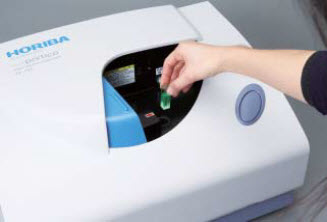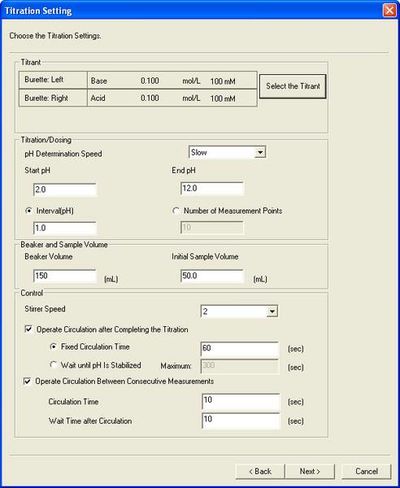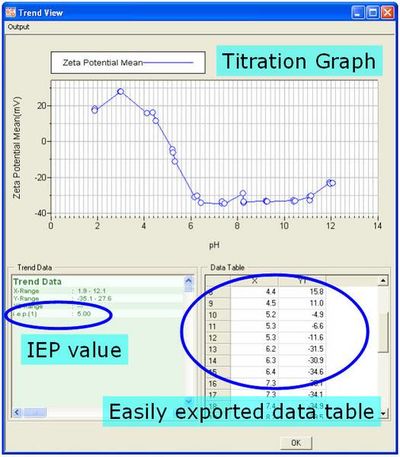

Zeta potential is the charge on a particle at the shear plane. This value of surface charge is useful for understanding and predicting interactions between particles in suspension. A large magnitude (either positive or negative), that is, over about 25 mV, zeta potential is generally considered an indication that the particle suspension will be electrostatically stabilized. Zeta potential can be measured with the HORIBA SZ-100 shown in Figure 1.

The SZ-100 Nanoparticle Analyzer
Zeta potential is a function of both the particle surface chemistry and the suspending medium chemistry (1). The ions that are at the particle surface and controlling surface potential are a function of the concentration and nature of the ions in the bulk liquid. In addition, the concentration of ions affects the distance over which charge effects persist. For example, a significant amount of dissolved salt will shield the electrostatic interactions between particles. Some ions, known as specific ions will prefer to stick to the particle surface as the concentration of these ions increases. Examples of specific ions include H+ and polyvalent ions. In this work, the effect of H+ concentration on particle surface charge is studied. Other examples of the effect of various ion concentrations can be found in (2) and (3).
Typically, and for good reason, H+ concentration is discussed in terms of pH. pH has a strong effect on the surface charge of many types of particles. In addition, pH is a parameter that is often and readily changed in a formulation. For these reasons, the effect of pH on particle surface charge is often studied. One number that characterizes a surface is the isoelectric point, IEP, or point of zero charge, PZC, which refers to the conditions, often pH, at which the particle surface charge is zero. At pH values lower than the IEP, the particle surface charge is positive and at pH values higher than the IEP, the particle surface charge is negative. One rule of thumb for stable suspensions is to ensure that the pH is one full pH unit away from the IEP.
Values of IEP are obtained by measuring the zeta potential as a function of pH and identifying the pH at which the zeta potential value crosses zero. In most cases this is achieved by interpolating the experimental data. Textbook values of IEP are often not useful for practical work since the value of IEP can change dramatically with even a small amount of impurity that is driven to the sample surface. IEP measurement results can also be affected by incomplete particle surface wetting or by the choice of surfactants. For example, adding TSPP to a metal oxide suspension will cause the IEP to shift to extremely low pH values or disappear altogether. For these reasons, IEP values are typically measured and that is a process that can be automated.
The automation of isoelectric point measurement is achieved with the HORIBA Autotitrator accessory for the SZ-100 shown in Figure 2. The Autotitrator automatically adds acid or base to adjust the pH of the sample, records pH, and loads the sample into the graphite electrode cell in the SZ-100. Zeta potential is then determined and the cycle is automatically repeated for the next pH in the series.

Autotitrator accessory (LY-711) for the SZ-100
Artificial coffee creamer was diluted until slightly cloudy in DI water. Sample pH was automatically decreased to pH 2 and then increased stepwise with the HORIBA Autotitrator. Zeta potential was measured with the reusable graphite electrode cell in the HORIBA SZ-100Z Nanoparticle Analyzer. Sample pH was measured with the HORIBA 9621C temperature-compensated pH electrode.
In this study, 100 mM nitric acid and 100 mM sodium hydroxide were used as the acid and base reagents respectively. The Autotitrator reagent containers include provision for molecular sieve treatment of incoming air that replaces removed titrant. The 5 mL burettes precisely deliver the reagents without bubbles eliminating the need for degassing. The smallest reagent dose that can be delivered manually is 0.0005 mL. The Autotitrator was set up in the software via a wizard type interface as shown in Figure 3 below. The available manual mode was not used in this study.

Setup wizard for the SZ-100 Autotitrator
The pH probe was filled and calibrated using HORIBA standard solution set 101-S. After cleaning, it was held in place over the sample beaker with an integrated ring stand. The integrated stir plate mixed the sample as reagent was automatically delivered. When the target pH was reached, a peristaltic pump rinsed the zeta potential cell and delivered the sample for measurement. The zeta potential was measured in triplicate and pH monitored for drift during measurement. Then, the cycle was repeated for the next pH in the series.
The zeta potential of the coffee powder suspension as a function of pH is shown in Figure 3 below. From pH 2 to pH 3, the zeta potential value of the coffee creamer emulsion increases. This is probably due to specific shifts in the structure of the emulsion at low pH. From pH 3 to pH 11, the shape of the curve is the classical backwards S shape. At low pH, the particle charge is positive due to the large H+ ion concentration. At high pH, the particle charge is negative due to the large OH- ion concentration. The obtained value of the isoelectric point where the zeta potential crosses from positive to negative is at pH 5. Finally, there is a decrease in the magnitude of the zeta potential between pH 11 and pH 13. This is either due to another structural shift in the emulsion or due to the shielding effect of the increased number of ions in the suspension. The main point of this plot is that the isoelectric point of this system is at pH 5.

Screen shot of results of automatic titration results with the SZ-100 and Autotitrator
The IEP of a suspension can be automatically determined using the HORIBA SZ-100 and the HORIBA Autotitrator. The IEP of this particular artificial coffee creamer was found to be at pH 5.
Nanoparticle Analyzer
Dynamic Image Analysis
Direct Imaging Particle Analyzer
Centrifugal Nanoparticle Analyzer
Laser Scattering Particle Size Distribution Analyzer
Laser Scattering Particle Size Distribution Analyzer
BET Flowing Gas Surface Area Analyzers
BET Surface Area Analyzers
Simultaneous Multi-Laser Nanoparticle Tracking Analysis (NTA)
Do you have any questions or requests? Use this form to contact our specialists.